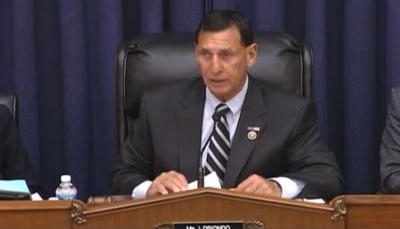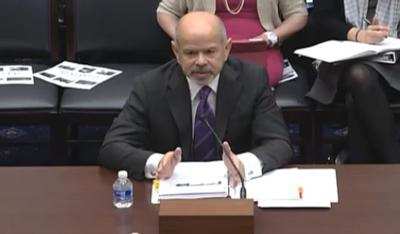Holds Initial Hearing With FAA Administrator Michael Huerta As The Only Witness On The Agenda
The House Transportation Aviation Subcommittee on Tuesday heard from FAA Administrator Michael Huerta as it began the process of crafting legislation to reauthorize the agency.

"As we draft a new authorization, there are several major areas this subcommittee is looking towards. Technological advances since the last bill are at the heart of two key areas of focus: the move towards GPS-based air traffic control under NextGen and the growth of commercial interest in unmanned aerial systems," said subcommittee chair Frank LoBiondo (R-NJ) (pictured) in his opening remarks. "These technologies hold enormous potential that could improve the efficiency and safety of our airspace system while unlocking billions of dollars in economic activity for the country."
"It is clear that progress has been made on NextGen. Some net benefits of NextGen are starting to be realized at select airports across the country, yet a great deal of work by the FAA to fully implement the program nationally remains. I would again convey that Congress as a whole is closely monitoring the FAA’s progress on NextGen and my colleagues will be looking at your use of resources and difficulty at meeting realistic deadlines.
"For the past year, we’ve received an extensive amount of input from stakeholders regarding the slow pace of FAA’s implementation of NextGen as well as the agency’s inefficient and overly burdensome certification processes. Many of these problems have been identified in several oversight hearings conducted by this subcommittee, as well by the DOT Inspector General and Government Accountability Office. In addition, I have raised them directly with Secretary Foxx and Administrator Huerta.
"Furthermore, after months of delay, the FAA finally released its proposed rule for the integration of small unmanned aerial systems or UAS into the National Airspace System. Unfortunately the reported timeline of 2017 for finalization of the UAS rule would ensure other countries move ahead of the U.S., reaping the economic benefits as well as preventing new American jobs from being created. I’d strongly urge the FAA to be more aggressive with UAS integration while better utilizing the FAA Technical Center and six test sites to achieve this shared goal. I stand ready to work with Administrator Huerta on this issue.
"As we move forward with the FAA Authorization Act, we must ensure that our efforts to address these long-standing problems do not adversely impact safety, which has and will continue to be the top priority of the Subcommittee."
Rick Larsen (D-WA), the subcommittee's ranking Democrat, pointed out that the current FAA authorization bill will expire in just eight months.
"There is no doubt that we have our work cut out for us. But I am personally committed to do my part to work along with Chairman LoBiondo to ensure that we complete a bill on time, without the need for an extension," Larson said in his prepared remarks.
"I expect we will cover a lot of ground, so let me walk through a few of my priorities briefly. I strongly believe that the reauthorization must maintain or enhance safety; invest responsibly in the aviation system; move NextGen forward; advance certification reform; and move closer toward safe integration of unmanned aircraft systems (UAS).
"First, safety. I want to be clear that I will not support any efforts to roll back any safety improvements of the past several years. The FAA has made great progress implementing the mandates of the Airline Safety and Federal Aviation Administration Extension Act of 2010, and any attempts to undo this work, including any weakening of pilot qualification rules, is a nonstarter for me.
"Next, investment. We must provide stable and adequate funding to mitigate the impacts that sequestration and budgetary constraints have had on the agency. In light of the FAA's ongoing fiscal challenges, potential reforms of the air traffic control system have been a popular topic of conversation. I have said this before, and I will say it again: reauthorization must not be a science experiment.
"Our air traffic system is not fundamentally broken. If we resolve to be “transformational,” we must do so with a clear statement of the problem we are trying to solve and clear understanding of how to solve it without compromising what is working—safety," Larson said.

In his prepared remarks, Huerta (pictured) said that aerospace industry is growing more complex, and is not the same industry as it was in decades past, or even a few years ago.
"Several factors in particular are increasing the complexity of the industry and introducing different types of safety risk into the system," Huerta said. "These factors include new aerospace designs and technologies (e.g., UAS), changes in the FAA’s surveillance and oversight model (e.g., designee management programs), and different business models for the design and manufacture of aircraft and products (e.g., more global supply chains). In order to leverage FAA’s limited resources, we must ensure that they are directed at areas with the highest safety risk. Because commercial aviation accidents are becoming rare occurrences, the FAA needs to build on these safety successes and identify and mitigate precursors to accidents to better manage aviation safety and ensure we continue to have the safest aviation system in the world.
Reauthorization can help us succeed with this initiative by establishing and fostering risk-based safety approaches to aviation oversight; expanding collaborative, data-driven safety processes with industry to improve safety; and accelerating risk-based certification mechanisms in order to achieve more streamlined processes in areas such as certification. I know you have heard from industry that this is important from their perspective in order to improve their competiveness in a global market.
"This initiative lays the foundation for the NAS of the future by achieving prioritized NextGen benefits, integrating new user entrants, and delivering more efficient streamlined services. The nation’s air traffic system is based on infrastructure that was largely built 50 years ago and is out of balance with our stakeholders’ changing needs and is increasingly costly to maintain. Over the past 10 years, the agency has seen dramatic technological change, fuel price fluctuations, congestion concentrated in fewer hubs and an increasing backlog of much needed infrastructure, maintenance and modernization.
"Building the NAS of the future and accommodating new services will require difficult decisions," Huerta said. "FAA needs the flexibility to modify its service levels to match changing industry air traffic demands. This is essential in order to reduce costs and become more efficient in the long run."
(Images from hearing video)
 Airbus Racer Helicopter Demonstrator First Flight Part of Clean Sky 2 Initiative
Airbus Racer Helicopter Demonstrator First Flight Part of Clean Sky 2 Initiative Diamond's Electric DA40 Finds Fans at Dübendorf
Diamond's Electric DA40 Finds Fans at Dübendorf ANN's Daily Aero-Term (04.23.24): Line Up And Wait (LUAW)
ANN's Daily Aero-Term (04.23.24): Line Up And Wait (LUAW) NTSB Final Report: Extra Flugzeugbau GMBH EA300/L
NTSB Final Report: Extra Flugzeugbau GMBH EA300/L Classic Aero-TV: 'Never Give Up' - Advice From Two of FedEx's Female Captains
Classic Aero-TV: 'Never Give Up' - Advice From Two of FedEx's Female Captains




